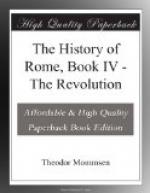The case is much the same with the advancement of the frontier; we know that formerly the Aesis, and in Caesar’s time the Rubico, separated the Celtic land from Italy, but we do not know when the boundary was shifted. From the circumstance indeed, that Marcus Terentius Varro Lucullus as propraetor undertook a regulation of the frontier in the district between the Aesis and Rubico (Orelli, Inscr. 570), it has been inferred that that must still have been provincial land at least in the year after Lucullus’ praetorship 679, since the propraetor had nothing to do on Italian soil. But it was only within the -pomerium- that every prolonged -imperium- ceased of itself; in Italy, on the other hand, such a prolonged -imperium- was even under Sulla’s arrangement—though not regularly existing—at any rate allowable, and the office held by Lucullus was in any case an extraordinary one. But we are able moreover to show when and how Lucullus held such an office in this quarter. He was already before the Sullan reorganization in 672 active as commanding officer in this very district (p, 87), and was probably, just like Pompeius, furnished by Sulla with propraetorian powers; in this character he must have regulated the boundary in question in 672 or 673 (comp. Appian, i. 95). No inference therefore may be drawn from this inscription as to the legal position of North Italy, and least of all for the time after Sulla’s dictatorship. On the other hand a remarkable hint is contained in the statement, that Sulla advanced the Roman -pomerium- (Seneca, de brev. vitae, 14; Dio, xliii. 50); which distinction was by Roman state-law only accorded to one who had advanced the bounds not of the empire, but of the city—that is, the bounds of Italy (i. 128).
28. As two quaestors were sent to Sicily, and one to each of the other provinces, and as moreover the two urban quaestors, the two attached to the consuls in conducting war, and the four quaestors of the fleet continued to subsist, nineteen magistrates were annually required for this office. The department of the twentieth quaestor cannot be ascertained.
29. The Italian confederacy was much older (ii. VII. Italy and The Italians); but it was a league of states, not, like the Sullan Italy, a state-domain marked off as an unit within the Roman empire.
30. II. III. Complete Opening Up of Magistracies and Priesthoods
31. II. III. Combination of The Plebian Aristocracy and The Farmers against The Nobility
32. III. XIII. Religious Economy
33. IV. X. Punishments Inflicted on Particular Communities
34. e. g. IV. IV. Dissatisfaction in the Capital, iv. V. Warfare of Prosecutions
35. IV. II. Vote by Ballot
36. IV. III. Modifications of the Penal Law
37. II. II. Intercession
38. IV. III. Modifications of the Penal Law
39. IV. VII. Rejection of the Proposals for an Accomodation




